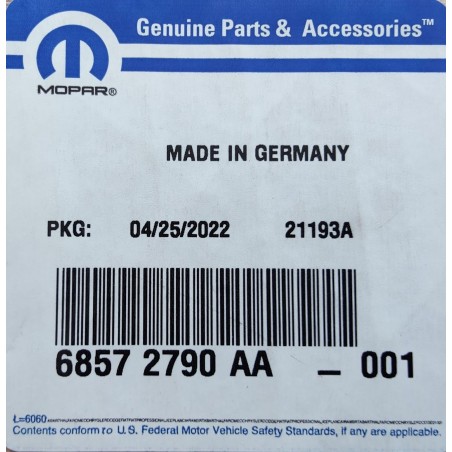- Kun online
- -20%
- Ikke på lager




in addition 1.500 kr deposit
Genuine Mopar Air Suspension Compressor - Made in USA
Mopar is the replacement part, accessory, and performance part division of Chrysler vehicles. Mopar is the official manufacturer of factory parts for Chrysler, dodge, Jeep®, and Ram. When you buy a genuine Mopar part you are buying the factory original part for your vehicle with an available factory warranty that can be claimed at Mr-Parts Sweden AB.
Can be installed in the following vehicles:
jeep Grand Cherokee IV WK, WK2 (2011-2020)
JEEP GRAND CHEROKEE Limited (2011-2018)
JEEP GRAND CHEROKEE Overland (2011-2018)
JEEP GRAND CHEROKEE Summit (2014-2018)
JEEP GRAND CHEROKEE Laredo (2011-2018)
JEEP GRAND CHEROKEE Trailhawk (2017-2018)
JEEP GRAND CHEROKEE Hemi SRT V8 (2015-2018)
JEEP GRAND CHEROKEE Hemi SRT8 V8 (2012-2014)
Original spare part number:
Compressor: 68232648AA
From air supply device:
68204730AG, 68204730AE, 68041137AF, 68204730AD
68204730AB, 68041137AG, 68204730AC, 68204730AF
68041137AD, 68041137AE, 68204730, 68041137, 68204730
Scope of delivery:
Compressor aggregate
CAUTION: The replacement of the relay is mandatory, otherwise the warranty on the compressor is forfeited!
Attention!!!
The vehicle suspension is based on a combination of electronically controlled level control and bellows filled with nitrogen 5 or CO2.
The gas pressure in the system MUST only be rebuilt after replacing any spare parts (such as compressor, valve, air spring and/or suspension strut) according to the vehicle manufacturer's specifications.
At this point the compressor is NOT used to refill the system.
These continental compressors, serve exclusively for pressure compensation in the closed system.
If you do not follow the installation instructions of the vehicle manufacturer, the compressor may quickly be damaged, resulting in loss of warranty.
The complete emptying of the system is the general specification of the car manufacturer for repairs to the spring system.
After replacing the corresponding spare part, the system MUST be refilled with CO2 or nitrogen 5 according to the vehicle manufacturer's instructions.
This can only be done with appropriate software and special tools.
Only then can you start further steps, such as calibration or commissioning of the level control.
Before purchasing a compressor, please note the following:
The most common reason for a defective compressor is a leak in the system, causing the compressor to run too long and too often.
An excessive number of switch-on cycles will cause the relay contacts to stick together.
As a result, the relay no longer functions.
The result is continuous current on the compressor.
The compressor runs continuously without control until it burns out.
Before a new compressor is installed, all the reasons why it has been damaged must be completely eliminated.
To the leak:
A leak can occur in many places, for example:
- Porous or damaged air springs or air spring parts (strut)
- Worn seals, defective compressed air connections and chafed compressed air hoses
- Leaky housings in components such as compressors, valves, air springs or suspension struts.
Every air spring system is vulnerable in this way.
Therefore, follow our advice to avoid any further repairs in the near future.
Our technical advise for the air supply device:
1. Increased noises while the compressor is running may be caused by a non-functioning compressor mounting.
Change the rubbers and springs of the mounting in any case.
2. A porous intake hose often is the cause for a breakdown of the compressor.
Change the intake hose and preferably also the filter and noise absorber, because we do not want the compressor to breakdown because of these.
3. Change the relays before installing the compressor even if it seems to still work.
This is also a specification by the car manufacturer. Be sure to change the right relays.
Relays look similar, that is why there is a risk to change the wrong relays.
4. Be sure to check whether the system is leakproof after repairing.
The easiest way to do this is to park the vehicle. Wait for the system to automatically re-adjust if your car has this feature.
Then measure the heights from the ground to the lower edge of the fender as exactly as possible and take notes.
On the day after measure these heights again and compare them with the ones before. Even a small difference will lead to a damaged compressor and damaged valves in the long run.
When driving with a leaking suspension for a long time it needs to be assumed that the compressor is running more often than normal. The increased number of cycles of powering on and off is likely to already have damaged the compressor. Depending on the duration of that condition you should change the relays and check the performance of the compressor to be on the safe side. After the vehicle stood overnight the compressor normally doesn't need to run more than 20 to 30 seconds for the system to be ready to start.